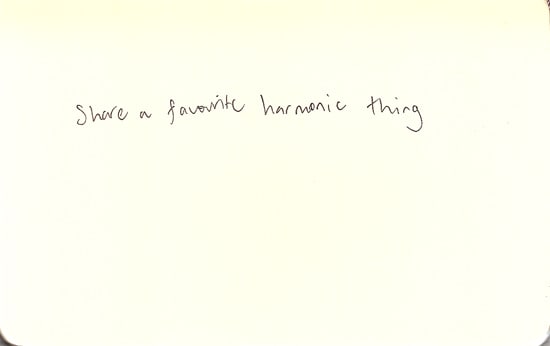Share a favourite harmonic moment.
I guess this could either be a chord change, or a bunch of chords. Or the sound of a chord, maybe. Often with a beautiful harmonic moment, it’s the accumulation of things that lead up to a harmonic shift. It might involve preparation, anticipation, surprise, modulation. All kinds of good stuff.
One of my favourite harmonic moments happens at the end of Chopin’s Prelude in E minor. It’s at 1:30 – 1:32 ish on this recording. Stomach crunching. It will make you want to curl up into a ball.
If you have Spotify, then you can share a nice harmonic thing by adding a track to this collaborative playlist, as well as checking out whatever else anyone adds. Be sure to point out what it is that’s so delightful to you in this here comment box.
*I should point out that if you read this blog via an RSS reader or you have it delivered to your e-mail, then you’ll miss the comments. These, if there are any, and the comment box are found on my site below the post. Please use it, as it’s so enlightening to read new ideas, turn over a few rocks, feel the sparks. And that is what this is all about :)

Great stuff, thanks for sharing :)
link here- http://www.youtube.com/watch?v=TN9a3M2YRq0
I really love 2.35-2.42 of this recording of Walton’s Piano Quartet, then the sequences from 3.11-3.25. I always think he cuts effortless through lovely changes, and his ideas would be great for soloing over!
All good stuff there, Chris. Lots of that kind of thing in country guitar playing and Frisell does that a fair bit, too. Best M
Thanks, Ruben. Love that tune. Thanks for taking the time to explain what’s happening, too :)
My favourite harmonic moments occur in the third movement of John Mclaughlin’s Mediterranean Concerto – particularly during the flute/guitar duet.
This might be a bit off-centre as I’m currently preoccupied with acoustic fingerstyle playing. However this is taking me into new spaces and forcing me to think about harmony in different ways. I’m using open strings when possible to get a harp-like sustain. I’ve figured out ways to play scales across the strings so the notes ring out together and I’m discovering a lot of new melody chord ideas using dissonance. Mostly these need to be played as arpeggios- don’t play all the notes at once! For example playing a C maj 7 fretting the C at fret 3 on the 5th string and the C on fret 5 of the 3rd string- with the other strings open; or add in a D on the second string and you are starting to build a “harp” scale across the strings. Another idea- In G, over something like G7/C7/F7/Bb7/A7/D7/G/D7: play the Bb7 in the bass with open strings on top (Bb – Ab D B E) or (Bb E Bb G B E) for a dissonant b9 b5 effect- you need to experiment with patterns across the strings. And this is a nice D half diminished with an open E string on top (- D Ab C F E ) which I use in “Over the Rainbow” which you can hear on my new YouTube channel here:
http://www.youtube.com/user/Chrisdoesguitar?blend=2&ob=5
From the pop idiom I love the harmony and melody of “In My Room” from the Beach Boys’ Surfer Girl album.
After setting us up with a pop cliche I vi ii V intro the verse starts by sitting on the tonic for a whole four bar phrase while the melody climbs the triad. The fifth bar is tonic also with the fifth in the melody, but then comes a lovely surprise a bVIImaj7 chord with the major 7 in the melody. This resolves back to tonic.
The bVIImaj7 feels surprising, I think largely due to the maj7th, but it also fits in a pretty traditional pop song as the only non-diatonic note in the chord is the root and the maj7th in the melody adds a much more progressive feel to the harmony than would be normal for this kind of song.